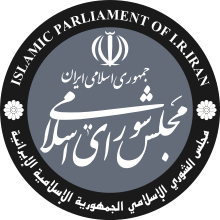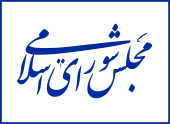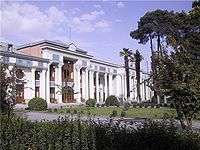Islamic Consultative Assembly
The Islamic Consultative Assembly (Persian: مجلس شورای اسلامی, romanized: Majles-e Showrā-ye Eslāmī), also called the Iranian Parliament, the Iranian Majles (Arabicised spelling Majlis), is the national legislative body of Iran. The Parliament currently has 290 representatives, changed from the previous 272 seats since the 18 February 2000 election. The most recent election took place on 21 February 2020 and the new parliament was opened on 28 May 2020.[2] The parliament has no major influence on foreign affairs or Iran's nuclear policy, which are determined by Ali Khamenei.[3]
Islamic Consultative Assembly مجلس شورای اسلامی Majles-e Showrā-ye Eslāmī | |
|---|---|
| 11th term | |
 | |
 | |
| Type | |
| Type | |
| History | |
| Founded | 16 November 1906 14 March 1980 (current form) |
| Preceded by | National Consultative Assembly |
| Leadership | |
Speaker | Mohammad Bagher Ghalibaf since 28 May 2020 |
First Vice | Amir-Hossein Ghazizadeh Hashemi since 28 May 2020 |
Second Vice | Ali Nikzad since 28 May 2020 |
| Structure | |
| Seats | 290[1] |
Political groups |
|
Length of term | 4 years[1] |
| Elections | |
| Qualified majority two-round system[1] | |
Last election | 21 February and 11 September 2020 |
Next election | 2024 |
| Meeting place | |
.jpg) | |
| Islamic Consultative Assembly Baharestan Tehran Iran | |
| Website | |
| http://www.Majlis.ir http://parlemannews.ir/ http://www.icana.ir/ | |
| Constitution | |
| Constitution of the Islamic Republic of Iran | |
 |
|---|
| This article is part of a series on the politics and government of Iran |
| Government of Islamic Republic of Iran |
|
Leadership |
|
Executive |
|
|
Supreme Councils |
|
Local governments
|
|
|
|
Outside government |
|
History
Islamic Republic of Iran
After the Iranian Revolution of 1979, the Senate of Iran was abolished and was effectively replaced by the Guardian Council thus the Iranian legislature remained bicameral. In the 1989 revision of the constitution, the National Consultative Assembly became the Islamic Consultative Assembly.
The Parliament of Iran has had six chairmen since the Iranian Revolution. Akbar Hashemi Rafsanjani was the first chairman, from 1980 to 1989. Then came Mehdi Karroubi (1989–1992), Ali Akbar Nategh-Nouri (1992–2000), Mehdi Karroubi (2000–2004), Gholam-Ali Haddad-Adel (2004–2008), Ali Larijani (2008–2020) and Mohammad Bagher Ghalibaf since 2020.
Over its history the Parliament is said to have evolved from being "a debating chamber for notables," to "a club for the shah's placemen" during the Pahlavi era, to a body dominated by members of "the propertied middle class" under the Islamic Republic.[4][5]
2017 attack
On 7 June 2017, there was shooting at the Iranian parliament and at the shrine of Ayatollah Khomeini.[6] Gunmen opened fire at the Iranian Parliament and the mausoleum of religious leader Ayatollah Khomeini in Tehran. The attack on the mausoleum reportedly left 17 persons dead and more than 30 people injured. The parliament was attacked by four gunmen which left seven to eight people injured. Both attacks took place around the same time and appear to have been coordinated.
Functions
The Islamic Consultative Assembly can legislate laws on all issues within the limits of the Constitution.[7] The Assembly cannot, for instance, enact laws contrary to the canons and principles of the official religion of the country (Islam) or to the Constitution.[8]
Government bills are presented to the Islamic Consultative Assembly after receiving the approval of the Council of Ministers.[9]
The Islamic Consultative Assembly has the right to investigate and examine all the affairs of the country.[10]
International treaties, protocols, contracts, and agreements must be approved by the Islamic Consultative Assembly.[11]
Receiving and issuing national or international loans or grants by the government must be ratified by the Islamic Consultative Assembly.[12]
The President must obtain, for the Council of Ministers, after being formed and before all other business, a vote of confidence from the Assembly.[13]
Whenever at least one-fourth of the total members of the Islamic Consultative Assembly pose a question to the President, or any one member of the Assembly poses a question to a minister on a subject relating to their duties, the President or the minister is obliged to attend the Assembly and answer the question.[14]
All legislation passed by the Islamic Consultative Assembly must be sent to the Guardian Council. The Guardian Council must review it within a maximum of ten days from its receipt with a view to ensuring its compatibility with the criteria of Islam and the Constitution. If it finds the legislation incompatible, it will return it to the Assembly for review. Otherwise the legislation will be deemed enforceable.[15]
Membership
Currently, there are 290 members of Parliament, fourteen of whom represent non-Muslim religious minorities (4.8%), and are popularly elected for four-year terms. About 8% of the Parliament are women, while the global average is 13%.[16] The Parliament can force the dismissal of cabinet ministers through no-confidence votes and can impeach the president for misconduct in office. Although the executive proposes most new laws, individual deputies of the Parliament also may introduce legislation. Deputies also may propose amendments to bills being debated. The Parliament also drafts legislation, ratifies international treaties, and approves the national budget.
All People's House of Iran candidates and all legislation from the assembly must be approved by the Guardian Council. Candidates must pledge in writing that they are committed, in theory and in practice, to the Iranian constitution.
Constituencies
The Parliament currently has 207 constituencies, including a total of 5 reserved seats for the religious minorities recognized by the constitution. The rest of 202 constituencies are territorial and coincide with 1 or more of Iran's 368 Shahrestans. The largest electoral districts are:
- Tehran, Rey, Shemiranat, Eslamshahr and Pardis (30 seats)
- Tabriz, Osku and Azarshahr (6 seats)
- Mashhad and Kalat (5 seats)
- Isfahan (5 seats)
- Shiraz (4 seats)
- Ahvaz, Bavi, Hamidieh and Karoun (3 seats)
- Ardabil, Nir, Namin and Sareyn (3 seats)
- Kermanshah (3 seats)
- Qom (3 seats)
- Urmia (3 seats)
Leadership

Members of Parliament elect their speaker and deputy speakers during the first session of Parliament for a one-year term. Every year, almost always in May, elections for new speakers are held in which incumbents may be re-elected.
The current Speaker of Parliament is Mohammad Bagher Ghalibaf, with First Deputy Speaker Amir-Hossein Ghazizadeh Hashemi and Second Deputy Speaker Ali Nikzad.
Committees
- Iranian Parliament Commission on Energy
- Iranian Parliament Commission on Economy
- Iranian Parliament Commission on National Security and Foreign Policy
- Iranian Parliament Commission on Health and Medicare
- Iranian Parliament Commission on Civil
- Iranian Parliament Commission on Cultural
- Iranian Parliament Judicial and Legal Commission
- Iranian Parliament Commission on Article Ninety of the Constitution
- Iranian Parliament Commission on Education and Research
- Iranian Parliament Commission on planning, budget and calculations
- Iranian Parliament Commission on Social
- Iranian Parliament Commission on Industries and Mines
- Iranian Parliament Commission on Agriculture, water and natural resources
- Iranian Parliament Commission on Council and Internal affairs
- Iranian Parliament Commission on Codification internal regulations
Current composition
The last elections of Parliament of Iran were held on 26 March 2016 with a second round will be held in April in those 71 districts where no candidate received 25% or more of the votes cast. More than 12,000 candidates registered but leaving about 6,200 candidates to run for the 290 seats representing the 31 provinces. The results indicate that the results would make a hung parliament with reformists having a plurality.
| Term | Composition ↓ | ||||
|---|---|---|---|---|---|
| 3rd |
| ||||
| 4th |
| ||||
| 5th |
| ||||
| 6th |
| ||||
| 7th |
| ||||
| 8th |
| ||||
| 9th |
| ||||
| 10th |
|
Building
After 1979, the Parliament convened at the building that used to house the Senate of Iran. A new building for the Assembly was constructed at Baharestan Square in central Tehran, near the old Iranian Parliament building that had been used from 1906 to 1979. After several debates, the move was finally approved in 2004. The first session of the Parliament in the new building was held on 16 November 2004.
The old building is depicted on the reverse of the Iranian 100 rial banknote.[17]
See also
- Subordinate organizations
References
- Nohlen, Dieter; Grotz, Florian; Hartmann, Christof (2001). "Iran". Elections in Asia: A Data Handbook. I. Oxford University Press. p. 64. ISBN 0-19-924958-X.
- [https://financialtribune.com/articles/national/96932/parliamentary-elections-set-for-feb-2020
- Iran announces low poll turnout, blames coronavirus 'propaganda' reuters.com
- Abrahamian, History of Modern Iran, (2008), p. 179
- Islamic Majles, Ashnai-ye Ba Majles-e Showra-ye Islami, Vol.ii (Guide to the Islamic Majles, Tehran, 1992, p. 205
- "Iran shootings: Parliament and Khomeini shrine attacked". BBC News. 7 June 2017. Retrieved 7 June 2017.
- Article 71 of the Constitution of Iran (1982-07-28), Constitution of the Islamic Republic of Iran wipo.int (accessed 2017-02-25)
- Article 72 of the Constitution of Iran
- Article 74 of the Constitution of Iran
- Article 76 of the Constitution of Iran
- Article 77 of the Constitution of Iran
- Article 80 of the Constitution of Iran
- Article 87 of the Constitution of Iran
- Article 88 of the Constitution of Iran
- Article 94 of the Constitution of Iran
- "On Women's Day, struggle for equality remains". Kyiv Post. 8 March 2012. Archived from the original on 1 April 2012.
- Central Bank of Iran. Banknotes & Coins: 100 Rials. – Retrieved on 24 March 2009.
![]()
External links
| Wikimedia Commons has media related to Islamic Consultative Assembly. |
- The official website of the Majlis of Iran
- Laws and minutes of meetings of the Majlis of Iran (1906-1979) (persian)
- History of Iran: Constitutional Revolution, a history of Majlis from 1906 to 1953
- Iranian Ministry of Interior on the history of elections in Iran
- A report on moving the Majles to Baharestan
- The Council of Guardians, Official website.
- The Majles, Iran's parliament news service.
- Interparliamentary Union (IPU) summary of Majlis of Iran election preparations and/or outcomes (translated into English)
- Iran Electoral Archive - Iranian Parliament
- Videos
- Iran’s ninth parliament PressTV (2012)
- Parliamentary election in Iran (I) (II) (III) (IV) (V) (VI) (VII) Second Round PressTV (2012)
- Video Archive of Iran's Parliament
- Kourosh Esmāili, People & Power: The Iranian Campaign, Aljazeera, YouTube, April 2008: Part 1 Part 2

.jpg)
